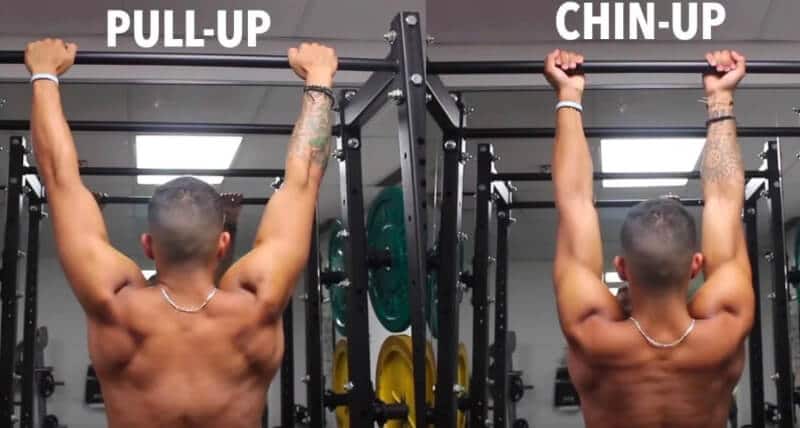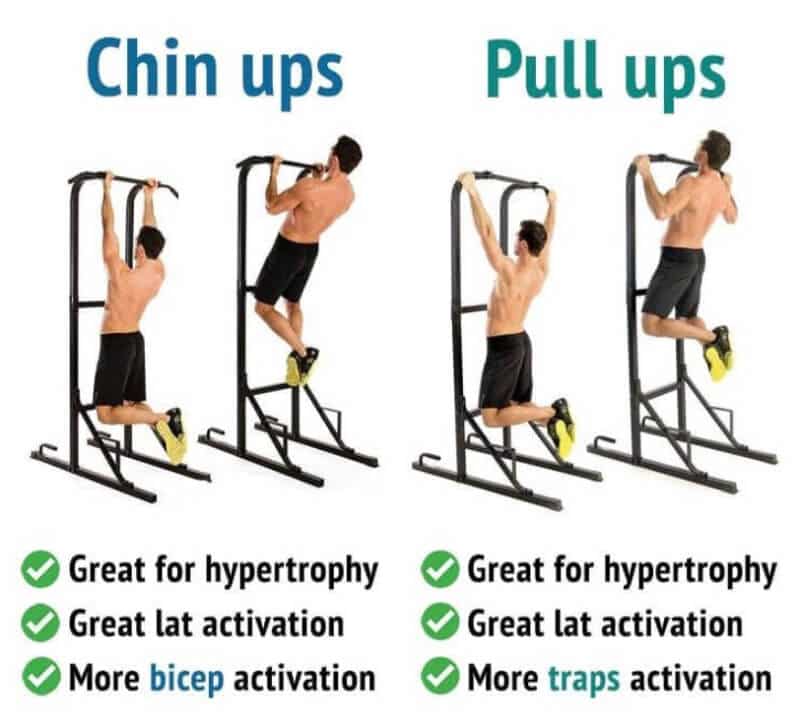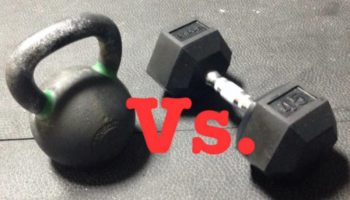Chin-up and pull-up are two of the most common upper body exercises.
Professional strength trainers and coaches consider these techniques a method to develop muscles and increase strength in the back and biceps.

Nogii acknowledges that there are similarities between chin-up and pull-up. However, fundamental differences are the crucial factors that can answer the question which one is better for you.
Scroll down and find what you need in this article!
Differences in Hand Position
Hand placement is the most apparent differences between chin-up and pull-up.
When doing chin-ups, you have a supinated (underhand) grip. It means that your palms that point inward are facing you. The grip width is equal to the shoulder width.
In contrast, pull-ups require a pronated (overhand) grip which allows your palms to point outward and away from you. The popular width of pull-up grip is little wider than shoulder width.
And, before moving to the next differences, there is a small reminder: Making the grip too wide is not an excellent idea. The wider your grip is, the higher the risk of shoulder injuries is. Keep it in your mind during your training sessions.
Differences in Strength
In general, chin-ups put your biceps in a stronger line of pull. In other words, with chin-ups, you use less physical power than pull-ups.
For example, at the same time, while a person can do ten chin-ups, perhaps he only does six pull-ups or even a lower number.
If you have a lat pull-down machine with grips or you often add weight when doing exercises, you will realize that you can do chin-ups with more extra weight than pull-ups.
Consequently, many experts advise beginners to start with chin-ups and after a training period, you can try pull-ups.
Be patient in case your pull-up performance is not as perfect as when you do the chin-ups. It is a normal thing, and you don’t need to worry about it.
Differences in Movements
Vertical pulling movement plane is a significant similarity between the two exercises. They have the same goals – targeting your back (especially your lats) and biceps.
However, it is inevitable that there are small differences between the movements of chin-ups and pull-ups.
With chin-ups, you will use shoulder extension, let your elbows come down and back from the front.
On the other hand, pull-ups require shoulder adduction. Your elbows will come down and back from the sides.
This difference is not enough to claim that which one is better. Because the purpose of both exercises is muscle development, so it is ideal to do chin-ups and pull-ups back and forth.
Differences in Working Muscle
Again, chin-ups and pull ups try to build your muscle and train your back (to be more precise – your lats) as well as your biceps.
It was originally believed that the differences in working muscle between the two techniques are quite significant.
However, through EMG testings, fitness experts pointed out that this statement is not true. Therefore, these slight differences cannot be reasons for you to neglect entirely one method and only focus on doing the other.
In case you have a particular problem, or you want to target a specific muscle group, you can spend more time on one method at the beginning phases.
Lats
The deciding factor which has significant effects on lats is the width of the grip.
If upper lats are your target, it is ideal to do chin-ups with a close grip. In the other case, if you want to train lower lats, you should take into consideration a wide grip with pull-ups.
Besides, pull-ups are recommended for additional upper back muscle building.
Traps
When it comes to traps training, scapular movement is an essential concern.
You can activate your traps by doing both two types of exercise. However, when compared with chin-ups, pull-ups need more strength, which makes the training process more effective.
Biceps
Your biceps support elbow supination, flexion, and forearm supination.
When doing pull-ups, your biceps will get worked. But, pull-ups use elbow extension instead of supination. Therefore, if you want to focus on strengthening the biceps, chin-ups are the better option.

Chin up Vs Pull up: Which one is better?
Which type of exercise will make your muscle building process more effective?
We have come across this question many times, and it is hard to claim which one is superior.
The right answer Nogii will give you is doing both two techniques together, or in other words, you can use a mix of different grips.
For instance, after eight weeks with chin-ups, you can practice pull-ups during the same amount of time. If you enjoy a neutral grip, you also might spend the next eight weeks for it, and then repeat your workout routine.
No matter what you are doing, the ultimate targets are the same – activating your arms, your shoulders, your back, and your trunk muscles.
But the differences between chin-ups and pull-ups do exist. Therefore, each level will have different suggestions.
Beginners
Generally, a beginner will meet with difficulties in the first or two pull-ups.
Don’t worry, let’s start with the most accessible exercise and after hard-working practices, you can try more demanding workouts.
The most suitable order you should consider is:
- Neutral-Grip
- Chin-ups
- Shoulder-Width Pull-ups
- Wide-Grip Pull-ups
Advanced Level
If you find pulling yourself over the bar very easy, it is time to take full advantage of the workouts you are doing.
When choosing your hand position, select the one which focuses on activating a particular muscle you want to train. Chin-ups will help you more with targeting biceps, and if you’re going to pay attention to hitting the lats, go with pull-ups.
We must repeat this:
Your back, traps, and biceps will get worked regardless of which grip you use. The difference here, in simple words, is how actually each technique activates a specific muscle group.
So if you have a particular purpose, do what is best for you that does not cause any pain or discomfort.
All In All
Whichever it is, chin-ups and pull-ups are both useful exercises that you should put together in your workout routine.
Nogii hopes that this article has provided an informative comparison and helped you know more about the differences between chin-ups and pull-ups.
Feel free to leave your thoughts in the comment section below and don’t forget, sharing is loving!




